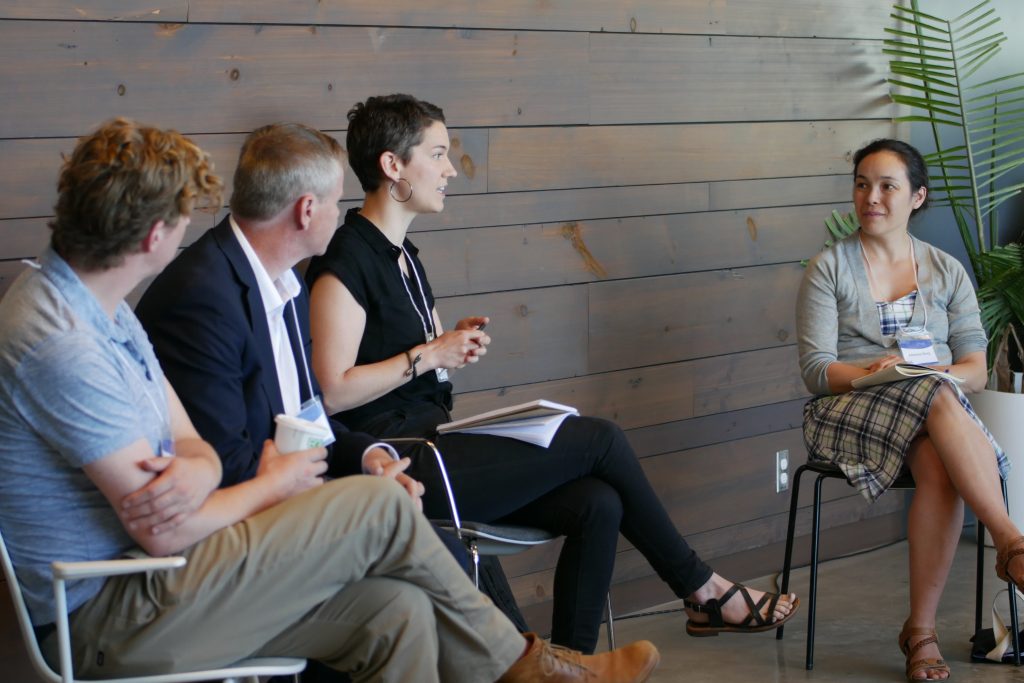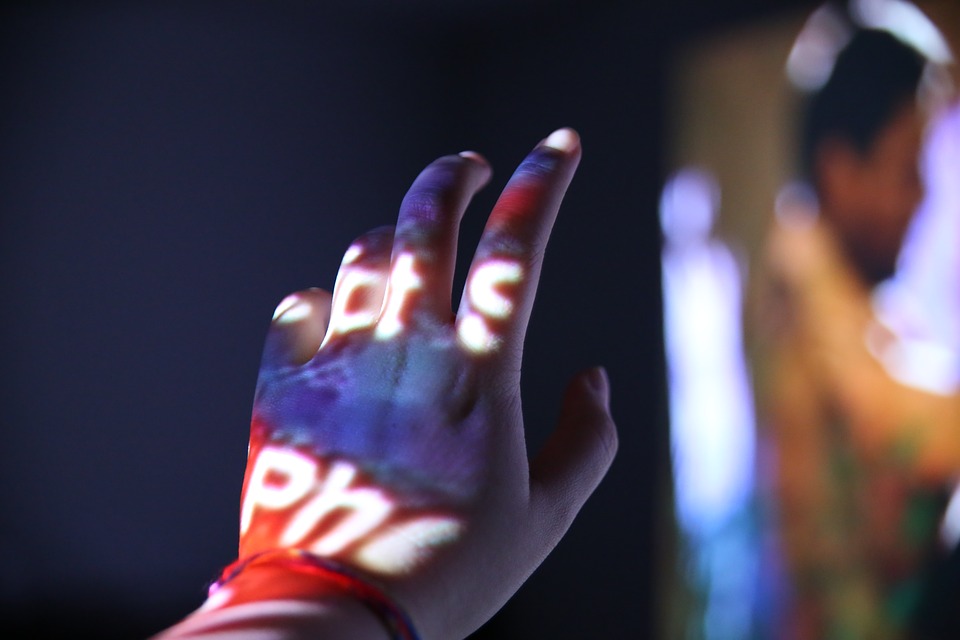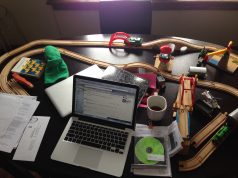This is the seventh in a series of articles capturing the planned conversations and discussions at the inaugural Festival of Live Digital Art (foldA), in Kingston ON, June 19-June 21, 2018. Milton Lim writes about a moderated conversation between Amy Chartrand, Jonathan Stanley, and Clayton Baraniuk that was presented in the Henry Preston Courtney and Lillian Courtney Lounge of the Isabel Bader Centre for the Performance Arts titled “Brass Tacks”.

Date June 21, 2018 Time 10:30 AM – 12:00 PM Location Conversation @ The Isabel
Brass Tacks: Speaking to logistics and possibilities in live performance, using digital media/communications.
On the morning of June 21st, we gathered beside a glass wall overlooking sunny Lake Ontario in the Henry Preston Courtney and Lillian Courtney Lounge at the Isabel Bader Centre for the Arts. Moderated by SpiderWebShow’s Adrienne Wong, Conversation #3 of the inaugural Festival of Live Digital Art consisted of three speakers: Amy Chartrand, a concept writer from the Montreal multimedia studio, Moment Factory; Jonathan Stanley from Audioconexus, a Kingston tourism company; and Clayton Baraniuk, a producer and trained relaxed performance consultant. Their profiles:
Moment Factory employs over 300 artists, programmers, coders, architects, and designers to create layers of video projection, sound, and lighting that together constitute immersive and often interactive arts and entertainment spaces. When they’re not in the studio for research and development, this company leverages the abilities of many artists to create large-scale works/events to bring people together. Their work is situated in stadiums, concerts, retail stores, casinos/resorts, and public parks.
Audioconexus provides robust multilingual and multimedia experiences for boats, trolleys, trains, and trams as a way to bridge linguistic and cultural barriers. Their work primarily involves using GPS triggered information in mapping audio theatre to physical objects/places/experiences to address the global shifts in international travel. Jonathan and his company are committed to extensive one-on-one research with clients, tailoring consumer content to site-specific experience.
Clayton Baraniuk’s portfolio as a relaxed performance consultant includes Canada’s National Arts Centre, Vancouver’s Electric Company, and foldA as the Access Coordinator. His work involves making works more accessible by utilizing technology and resources to support the variety of ways in which we receive/output information. For foldA, Clayton sent early footage of performances to an audio describer in Toronto, then used teleconferencing in addition to audio assisted listening technology that was already installed in the Isabel Bader Centre to remove the barriers of time and money for sending interpreters.

The conversation between the panelists consisted of familiar topics such as the bi-directionality of art dictating the use of technology and vice-versa, inquiries to Clayton as to what point accessibility and inclusivity is woven into the creation process, and questions from Jonathan as to how we use technology to reach larger audiences/communities.
As the conversation continued, I kept considering the composition of the panel members in front of us and how their distinct access to resources and levels of funding can radically change what might constitute their ‘brass tacks’ or the ‘essentials’ necessary for digital experimentation.
Side note: I’ve been thinking about how the coupling of arts funding and not-for-profit models have come to contextualize the work of artists as community-engaged culture makers. Furthermore, as a by-product of relying on precarious forms of capital (ie grants and foundations), communities of artists then operate in a paradigm of scarcity, even when they participate in the research or experimentation around digital technology, a sector that is increasingly profit driven. I felt like I was seeing some of this disconnect in front of me and in the room.
As we approached the question portion, similar concerns arose from independent artists in the audience regarding accessibility to expensive new technologies and the necessary digital literacy that is required to utilize them. I definitely wasn’t the only one thinking along these lines.
An excerpt from Moment Factory’s website, on ‘experiential marketing’:
“Modern marketing is all about relationships and emotion – keeping people engaged, building loyalty, and reinforcing distinctive brand identity. … From fun, unexpected stunts to jaw-dropping immersive shows, we take consumer experiences to a whole new level.”
Moment Factory’s language is distinctly set in business and marketing vocab, though it’s notable that this increased articulation around the commodification of experience and affect has permeated both arts and entertainment sectors.

As for-profit enterprises continue to be far more lucrative avenues for digital experimentation, I am witnessing peers—technologists and media artists who are altering their practices in order to exist in and across for-profit and not-for-profit sectors or they abandon the arts industry entirely. This further distances the arts community’s access to necessary knowledge and resources which produces an integral opportunity then, to reconsider the framework within which arts funding is distributed and how we relate to these models of working. This brings up three main considerations for me:
- That we meaningfully bridge the perceptual divide between arts vs entertainment organizations so as to access resources and open channels of knowledge exchange (eg. theatre performance + video game companies and the exploration of participatory mechanics and immersive narrative).
- That we directly address the inflexibilities of the not-for-profit model in performing arts contexts that places limitations on the allocation of resources towards research and development with hardware, and on purchasing/holding the necessary capital assets for tech innovation. And to a certain extent, I even mean challenging the very notion of the arts as ‘not-for-profit’.
- That we look within our arts community to designers and media artists who already work with new technologies, thereby widening the institutional scope of what skills we have access to in order to facilitate skilling-up opportunities.
Certainly a lot of the above is already being attempted through various channels such as Canada Council for the Arts’ Digital Strategy Fund and the events here at foldA, including the endeavours of these three panelists/organizations. But institutions take a long time to change. In the coming years, I suspect that we’ll still be faced with the continuous growth of the economic divide, but we’ll have some new toys, and more reliable and affordable consumer technology. And if we’re lucky we’ll have in place some efficient strategies of pooling resources and provisions for equitable access to digital tools across our communities.









